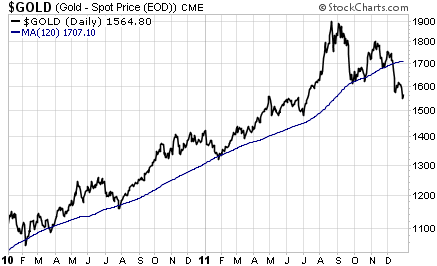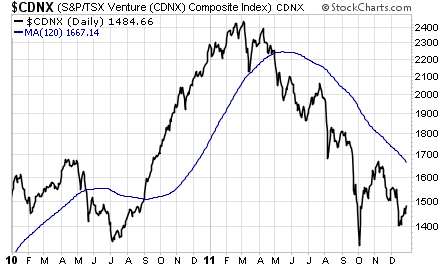 Buying small gold stocks is still a dangerous bet right now…
Buying small gold stocks is still a dangerous bet right now…
Over the past two months, most any gold stock – large or small – has suffered a big selloff.
The large-cap gold fund (GDX) is down 17% since November… and many small “junior” miners are down over 33%.
Any selloff like this has me interested in bargain hunting…
Last month, I showed you a list of some of the most promising small gold stocks in one of the most promising gold-producing regions in the world.
[ad#Google Adsense 336×280-IA]They’ve gotten incredibly cheap.
But, I wrote, political and economic troubles around the world have investors skittish. Even the weather is working against these stocks. They’re all located in the Yukon, which is pretty much shut down for the winter.
That’s a long list of reasons to wait to buy. But there’s one reason even more important than those. And it’s reason to hold off on most any precious metal-stock purchase for a little longer…
That reason is the TREND.
In my S&A Junior Resource Trader, we keep a close eye on the big trend in many different commodity sectors. When it comes to commodity stocks, even the best operators get hammered when the price of their underlying commodity is sinking.
We keep track of the trend with a simple tool called the “moving average.”
A moving average is a technical indicator that works by collecting a bundle of an asset’s closing prices – say, each one from the past 120 days – then taking the average of those prices.
Figuring the moving average and then plotting it each day produces a chart line that “smoothes” out market volatility so we can gauge the general trend.
When a market is trading above its moving average, it’s considered to be in a bull trend. When a market is trading below its moving average, it’s considered to be in a bear trend.
I like to use a 120-day moving average because it shows the general trend over an intermediate time frame (about four months).
Gold is now 8% below its 120-day moving average (DMA). That means the trend in gold is bearish. Silver is now more than 21% below its 120-DMA. The trend in silver is bearish. And these bearish trends have hammered precious metal stocks.

It’s even more evident in the chart of the Toronto Venture Exchange Index below. Small resource stocks are well below their 120-DMA… and still falling.

When you see charts like this, you need to be cautious. This train is clearly going in the wrong direction.
Ideally, we want to see gold and silver prices stop falling and cross above their 120-DMAs. Keep in mind, using this “trend gauge” is no magic bullet. It simply gives us a good general view of where the trend is… it keeps us from swimming against the current of a raging river.
The long-term bull case for gold and silver is still intact. The U.S. and Europe still have huge debts and unfunded liabilities that can only be paid back with devalued paper money (which is bullish for precious metals). And the growing economies of Asia are still accumulating more gold each year.
This bullish fundamental tailwind should cause the downtrend in gold and silver to turn higher soon. Our trend gauge could say “buy” in just a few weeks. But right now, prices are still falling… this falling knife hasn’t hit the floor yet. As soon as it does, I’ll let you know… And I’ll let you know how to get long gold.
Good investing,
Matt Badiali
[ad#jack p.s.]
Source: The Growth Stock Wire
